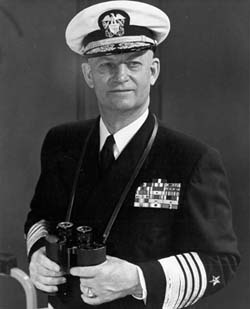 |
Chief of Naval Operations Admiral Arleigh Burke, proponent of "finite deterrence" nuclear deployments [Digital image courtesy of David A. Rosenberg] |
|
Washington, DC, March 25, 2011 - Ron Rosenbaum's new book, How the End Begins: The Road to a Nuclear World War III, praises the National Security Archive's Nuclear Vault as an "astonishing compilation of declassified discussions about the bomb." Rosenbaum, a columnist for Slate Magazine and the author of several well-received books, including Explaining Hitler and The Shakespeare Wars, has explored the danger of nuclear weapons since the late 1970s, when he published a major piece in Harper’s on nuclear command and control and weapons and the problem of “moral choice” raised by the existence of nuclear war plans like the SIOP (Single Integrated Operational Plan). In this new and highly original book, Rosenbaum revisits these issues in an extended meditation on the risks of nuclear catastrophe in the 21st century world. By looking at the careers of key individuals such as Bruce Blair, Colonel Valery Yarnich, and Harold Hering, the challenges posed by Iran’s nuclear ambitions and Israel’s nuclear arsenal, and why the post-war system of deterrence could break down, Rosenbaum shows why nuclear peril did not go away when the Cold War ended.
In the final chapter of How the End Begins Rosenbaum discusses proposals for nuclear abolition, including the “Global Zero” campaign organized by Bruce Blair and others. “Pessimistic” about the near-term possibility of abolition, not for lack of sympathy, but because he sees formidable obstacles to its realization, Rosenbaum finds other means to avoid a nuclear holocaust. One of them he found on the National Security Archive’s Web site. While researching his book, he visited the Archive, interviewed senior analyst William Burr, and explored the resources on The Nuclear Vault. There he discovered a collection of U.S. Navy proposals from the late 1950s, first advanced by Chief of Naval Operations Arleigh Burke, for “finite deterrence” based mainly on ballistic missile launching nuclear submarines (SSBNs).
Virtually undetectable, SSBNs developed capabilities allowing them to fire missiles thousands of miles from their targets. What drew Rosenbaum to the older Navy proposals published in the Archive’s online collection is the argument that the relative invulnerability of the SSBN would minimize the risk of the “use or lose” posture of vulnerable ground-based missiles and bombers. But Burke lost the argument to the Air Force, and U.S. policy took a “terrible wrong turn,” Rosenbaum argues. He sees Burke’s proposal as the “sanest solution to an insane, obscene problem,” although he admits that it carries its own risk of a holocaust. Proponents of “zero” are likely to take exception to Rosenbaum’s conclusion, but an important and interesting discussion should ensue.
Interested readers can see the Burke proposals and related materials in National Security Archive Electronic Briefing Book 275, "How Much is Enough?": The U.S. Navy and "Finite Deterrence,” May 1, 2009.
Thanks to Simon & Schuster for permission to use excerpts from Ron Rosenbaum's book.

